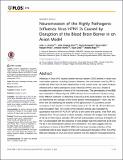| dc.contributor.author | Chaves, Aida J. | |
| dc.contributor.author | Vergara-Alert, Júlia | |
| dc.contributor.author | Busquets, Núria | |
| dc.contributor.author | Valle, Rosa | |
| dc.contributor.author | Rivas, Raquel | |
| dc.contributor.author | Ramis, Antonio | |
| dc.contributor.author | Darji, Ayub | |
| dc.contributor.author | Majo, Natalia | |
| dc.date.accessioned | 2020-06-15T23:24:51Z | |
| dc.date.available | 2020-06-15T23:24:51Z | |
| dc.date.issued | 2014-12-15 | |
| dc.identifier.uri | http://hdl.handle.net/11056/17575 | |
| dc.description.abstract | Influenza A virus (IAV) causes central nervous system (CNS) lesions in avian and mammalian species, including humans. However, the mechanism used by IAV to invade the brain has not been determined. In the current work, we used chickens infected with a highly pathogenic avian influenza (HPAI) virus as a model to elucidate the mechanism of entry of IAV into the brain. The permeability of the BBB was evaluated in fifteen-day-old H7N1-infected and non-infected chickens using three different methods: (i) detecting Evans blue (EB) extravasation into the brain, (ii) determining the leakage of the serum protein immunoglobulin Y (IgY) into the brain and (iii) assessing the stability of the tight-junction (TJ) proteins zonula occludens-1 and claudin-1 in the chicken brain at 6, 12, 18, 24, 36 and 48 hours post-inoculation (hpi). The onset of the induced viremia was evaluated by quantitative real time RT-PCR (RT-qPCR) at the same time points. Viral RNA was detected from 18 hpi onward in blood samples, whereas IAV antigen was detected at 24 hpi in brain tissue samples. EB and IgY extravasation and loss of integrity of the TJs associated with the presence of viral antigen was first observed at 36 and 48 hpi in the telencephalic pallium and cerebellum. Our data suggest that the mechanism of entry of the H7N1 HPAI into the brain includes infection of the endothelial cells at early stages (24 hpi) with subsequent disruption of the TJs of the BBB and leakage of virus and serum proteins into the adjacent neuroparenchyma. | es_ES |
| dc.description.abstract | El virus de la gripe A (VIA) causa lesiones en el sistema nervioso central (SNC) en las especies de aves y mamíferos, incluidos los seres humanos. Sin embargo, no se ha determinado el mecanismo utilizado por el IAV para invadir el cerebro. En el trabajo actual, utilizamos pollos infectados con un virus de la gripe aviar altamente patógena (HPAI) como modelo para dilucidar el mecanismo de entrada del IAV en el cerebro. Se evaluó la permeabilidad de la BBB en pollos de quince días de edad infectados y no infectados por el H7N1 mediante tres métodos diferentes: i) la detección de la extravasación del azul de Evans (EB) en el cerebro, ii) la determinación de la fuga de la proteína sérica inmunoglobulina Y (IgY) en el cerebro y iii) la evaluación de la estabilidad de las proteínas de unión estrecha (TJ) zonula occludens-1 y claudina-1 en el cerebro de los pollos a las 6, 12, 18, 24, 36 y 48 horas posteriores a la inoculación (hpi). El inicio de la viremia inducida se evaluó mediante RT-PCR cuantitativa en tiempo real (RT-qPCR) en los mismos puntos temporales. El ARN viral se detectó a partir de 18 hpi en muestras de sangre, mientras que el antígeno IAV se detectó a las 24 hpi en muestras de tejido cerebral. La extravasación de EB e IgY y la pérdida de integridad de los TJs asociada a la presencia del antígeno viral se observó por primera vez a 36 y 48 hpi en el palio telencefálico y el cerebelo. Nuestros datos sugieren que el mecanismo de entrada de la IAAP H7N1 en el cerebro incluye la infección de las células endoteliales en etapas tempranas (24 hpi) con la subsiguiente alteración de las TJs del BBB y la fuga del virus y las proteínas séricas hacia el neuroparenquima adyacente. | es_ES |
| dc.description.sponsorship | Universidad Nacional, Costa Rica | es_ES |
| dc.language.iso | eng | es_ES |
| dc.publisher | PLOS ONE | es_ES |
| dc.rights | Acceso abierto | es_ES |
| dc.source | PLoS ONE 9(12): e115138. | es_ES |
| dc.subject | VIRUS DE LA INFLUENZA AVIAR | es_ES |
| dc.subject | POLLOS | es_ES |
| dc.subject | CHICKEN | es_ES |
| dc.subject | INFLUENZA A VIRUS | es_ES |
| dc.subject | VIRUS | es_ES |
| dc.title | Neuroinvasion of the highly pathogenic influenza virus H7N1 is caused by disruption of the blood brain barrier in an avian model | es_ES |
| dc.type | http://purl.org/coar/resource_type/c_6501 | es_ES |
| dc.description.procedence | Escuela de Medicina Veterinaria | es_ES |
| dc.identifier.doi | https://doi.org/10.1371/journal.pone.0115138 | |

